Photo exhibition: Knots and Splices
Date
04.06.2023 - 31.12.2023
New photo exhibition by Jaan Künnap “Knots and Splices” has opened on the panoramic floor of the Tallinn TV Tower.
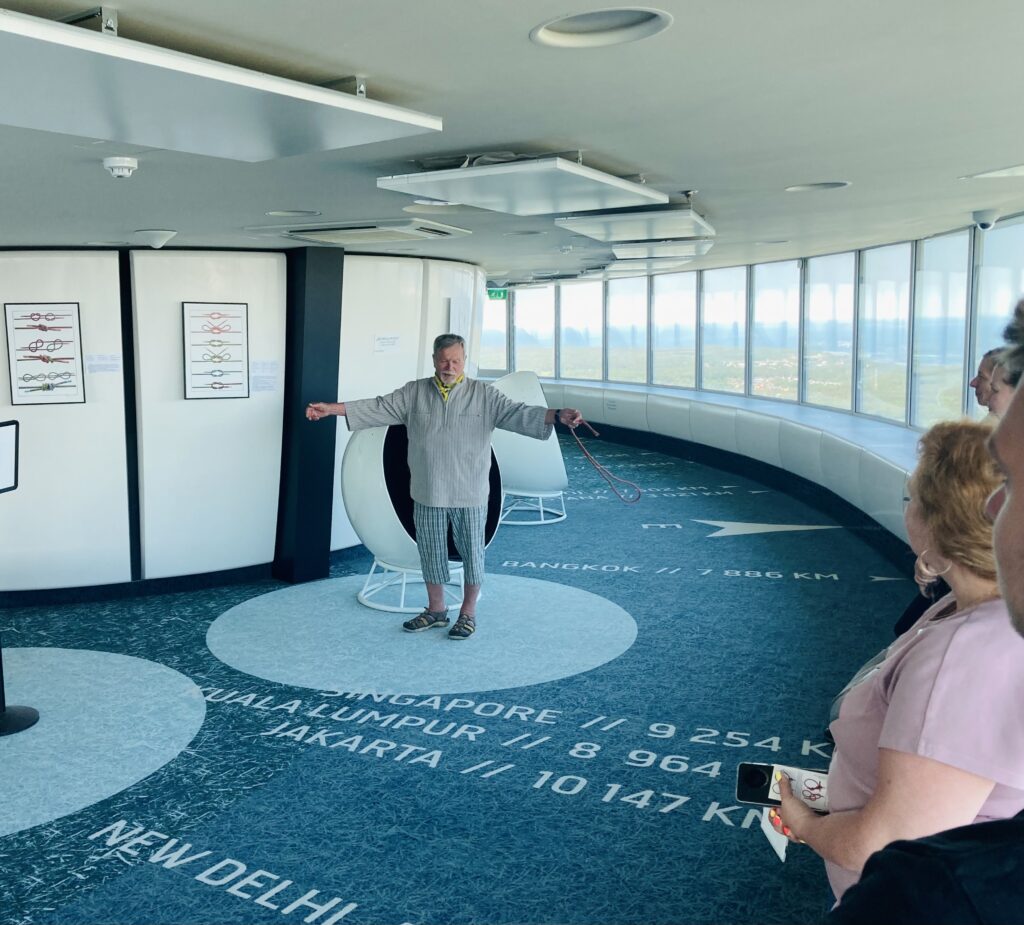
Jaan Künnap (born February 9, 1948 in Kõue) is an Estonian photographer, mountaineer and instructor-trainer, who has climbed to the top of more than 150 mountains. However, he discovered knots while working on a rescue ship instead.
In the Soviet army J.Künnap learned how to be a diver. Not to be confused with a scuba diver who swims in the water with flippers and then examines the area. Included in the diving gear besides everything else are also shoes made out of tin (both being 14kgs each), a big diving helmet and weights that were strapped around the body (both in the front and back, 18kgs each). All of that to do work underwater, for example to lift heavy weights. Jaan’s diving record in 80m deep.
As a paratrooper, Jaan has jumped with a parachute and diving equipment three times from an airplane (aprox. from a 1km height). He didn’t know how to control the parachute since he wasn’t a parachutist. For practice in the water, he had to dive 30m and come back to the surface after 4 hours.
When he left the army, he went to work as a diver on a rescue and salvage ship where he also lived. The reason being that during the Soviet times apartments weren’t easily given to Estonians. That lasted for 23 years (1969-1992) where he lived and worked on a ship while waiting for an apartment.
In the army, Künnap enjoyed literature about photography out of boredom and came back with a camera. Since Jaan was physically fit and he could tie knots then a coworker invited Künnap as a photographer to take pictures of the mountains. Jaan got a role as the group leader. Their first excursion was to Mount Elbrus in Russia. Künnap has been there 30 times.
Knots and Splices have played a big role in Jaan’s life, both on the sea and in the mountains where his friend’s life or his own has been “hanging on by a thread” multiple times. Thanks to his knowledge about knots, and how to use them, a lot of people’s lives have been saved and so has he been saved.
80% of all knots in the world were invented by sailors, and there can be more than one way to tie a single knot. Knots are used by sailors, alpinists, hikers, anglers and hunters, arborists and actually all people in their everyday life (shoelaces, ties, surgeons sewing, etc.).
The overhand knot is the simplest of all knots and is the first knot that everyone learns in their life. This knot is one of the basic binding options and is the basis for many other knots. For some knots, an overhand knot is made as a control knot to ensure reliability. This provides additional insurance that the main knot will not unravel. Since the knot is useful both as a handle and as a stop, it is tied into the lifelines at regular intervals to prevent the rope from slipping through the hand.
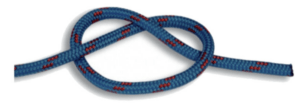
The square knot (also right, sailor’s, slang, reef knot) is a simple and quick knot to tie. In case of high tension, especially if the line gets wet, the blind knot will run tight. Tire knot with eyelets – usually used to tie shoelaces. A good feature is that the knot is easy to disassemble. (Photo in exhibition no. 10 (1))
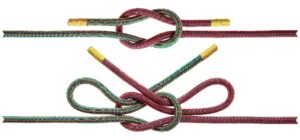
The fisherman’s knot, or anchor knot, consists of two simple sliding knots. The knot is used to connect two ends of the same thickness if the connection does not need to be disconnected later. The knot is reliable, relatively small and compact in size. According to Künnap, this knot should be teached to every child. The knot is also known as the angler’s knot and the lover’s knot. (In the first picture, the control nodes are made at the ends) (Photo in exhibition No. 9 (1))
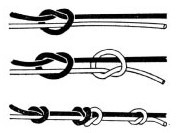
Timber hitch – the simplest and strongest, universal knot. If there is no weight behind, it is easy to untie. With this knot, for example, cables were carried from the mainland to the island. Hunters use it to pull out the carcass or a car can be pulled out. (Photo in exhibition no. 13 (3))
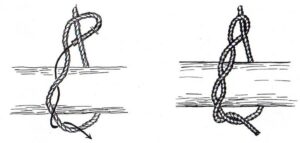
A bale knot, or British variant of a bale deck, is used to make loop on a wire rope or line. The bale knot has a very wide range of applications, particularly in situations where a high degree of reliability is required (e.g., to hoist an unconscious person on board). The bale knot will never collapse. It is used to tie the end of the rope around the anchor. It is the main knot for attaching equipment to a rucksack or harness. It can also be used to tie a rope around the body, either for safety or to carry over an obstacle. It is often used in mountaineering. NOTE: The bale knot can slip loose, so it is essential that a control knot is always attached to the free end of the rope! (no control knot in the picture) (Photo in exhibit no 13 and 14).
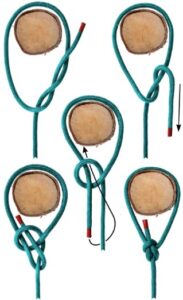
SPLICE: a braided wire rope connector used to join two wire ropes or to make a loop (ou) at the end of one wire rope. It is called splicing. Splicing is used, for example, to make safety nets for boat rails and adventure trails (photo 15).
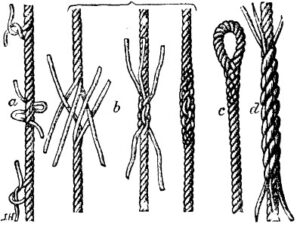
ENDS AND LINES: In seafarers’ parlance, the common name for ropes and cables is ends. In common parlance, ropes and cables are called ‘rope’ in the fishing industry. Rope twisted or braided from vegetable and man-made fibers with a circumference of less than 1 inch (25mm) is called a line, rope with a circumference of more than 1 inch is called an end. Line is used for fastening tarpaulins, as a flagpole and elsewhere. Question: What is the shortest end of the ship? Answer: the tip of the bell spout.
OU (aka eye): a part of a rope bent into a loop, the end of which is attached to the rope by splicing or stamping. A knot is a loop made without a knot – by splicing.
Come learn more about knots at the exhibition and try tying them yourself!
The exhibition can be accessed with an entrance ticket and remains open during the opening hours of the TV Tower until the end of 2023.
A tower-full of experiences awaits you!